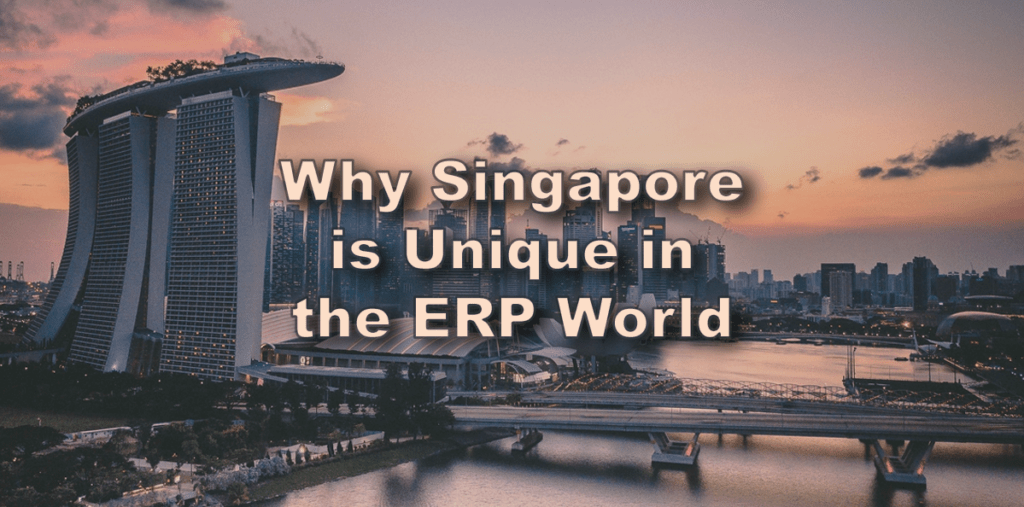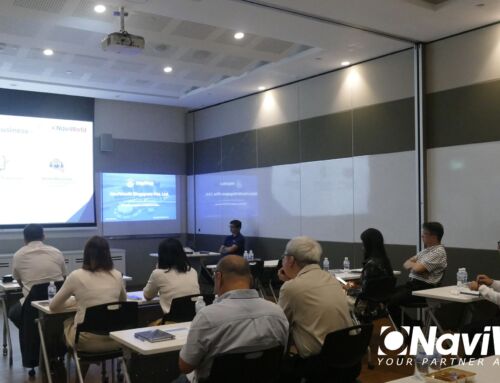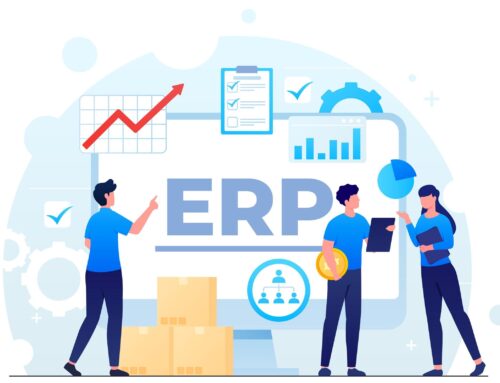What is the first thing that comes to mind when you hear of the term, ERP? Do cars and electronic gantries come to mind, or something else entirely? In Singapore, ERP is often associated with Electronic Road Pricing. However, in other countries, ERP is usually synonymous with Enterprise Resource Planning. These two names – electronic road pricing and enterprise resource planning – are not related and have a very vast difference in meaning. This article is referring to Enterprise Resource Planning (ERP) and seeks to explain why Singapore is unique in the ERP world.
What is Enterprise Resource Planning (ERP)?
ERP is a business process management software that manages and integrates a company’s financials, supply chain, operations, reporting, manufacturing, and human resource activities. Most companies have some form of finance and operational system in place. However, most of the software outside are unable to go beyond everyday business processes or help with future business growth. As the needs of a company change and expands, their system should also keep up with the transition.
In the past, businesses had some accounting, finance, or HR processes in place. Yet, the issue comes when these software systems worked separately and did not “talk” or work with one another. Data needs to be pulled from separate databases and entered manually, increasing room for human errors and duplicate data entry.
In contrast, modern ERP software brings all these different processes together to collaborate and form a fluid system. Current solutions also allow each department to see what the other is doing instantly. One significant impact of having an ERP system is the ease of communication between departments and streamlining of business operations. For instance, accounting and HR managers can now easily collaborate with sales and customer relationships officers in identifying sales opportunities.
In the wake of the coronavirus pandemic, digital initiatives have increasingly gained importance for companies to stay relevant. And Enterprise Resource Planning (ERP) systems, are becoming an integral part of the business landscape. ERP systems help companies to streamline their business processes, but to also efficiently manage their operations.
Tiers of ERPs
The tiered classification of enterprise software systems initially emerged in the mid-’80s. Consequently, ERP systems still apply a three-tier approach which should be considered when you are making your selection. Be it in vetting the scope of your ERP project, complexity and price of the ERP software products.
ERP Vendor Tier 3
This level applies to enterprises that fall into an annual gross revenue range of USD 0 – USD 20 million. Examples of this tier are SAGE 300 and most of the local ERP solutions. Some accounting software that branded themselves as an ERP tends to fall into this tier.
ERP Vendor Tier 2
This level applies to enterprises that fall into an annual gross revenue range of between USD 20 million – USD 250 million. Examples of this tier are SAP Business One, Microsoft Dynamics 365 Business Central and Netsuite.
ERP Vendor Tier 1
Enterprises that fall into an annual gross revenue range of between USD 250 million and beyond deploys this level of ERP tier typically. Examples of this tier are SAP S4 Hana, Oracle’s ERPs, Microsoft Dynamics 365 Finance and Operations and Epicor’s.
Today, the distinction of tiers may not be so clear. And many of the large enterprises may not be implementing tier-one ERP all the time. In my article about “How are the Changes in the ERP Market Affect Companies in Singapore“, I explained why you should avoid big tier-one ERPs.
Furthermore, life is not so simple in Singapore’s context.
What Makes Singapore Unique in the ERP World
Singapore is unique when coming to the adoption of ERP. The various reasons are as follow:
1. Big Companies are Not that Big
Big companies in Singapore are not that big in ERP terms.
Small Medium Enterprises (SME) in Singapore are defined as companies with group annual sales turnover of less than $100 million or group employment size of not more than 200 workers. In Singapore, currently, there are approximately 219,000 small and medium-sized enterprises (SMEs). SMEs makes up 99% of all domestic companies and contributes to 50% of the national Gross Domestic Product.
In ERP term, any company with annual revenue below USD 20 million is classified under tier 3 ERP. Tier 3 ERPs are the smallest ERP that usually has limited configuration ability. However, many Singapore companies with annual revenue below USD 20 million may have the resources to implement larger tier 2 ERP.
2. Strong Government Support
Another unique aspect is the strong support shown by the Singapore government for local companies in adopting digital technologies, such as an ERP system. Such strong government support is commonly unseen in other countries, considering the heavy costs involved in such initiatives. For more information on the government grants available, you can visit the Business Grant Portal.
Most ERP projects should be applied under the Enterprise Development Grant (EDG), although Singapore companies can apply for the pre-approved Productivity Solution Grant (PSG). The PSG is a viable option if they are selecting a tier 3 ERP, or looking at digital transformation at a smaller scale such as basic accounting abilities.
However, I strongly discourage Singapore companies to go for the PSG if they are looking at implementing an ERP system. This is because an ERP project will hardly fit well in a pre-configured solution. The advantage of an ERP solution is in its ability to configure the software to meet most business requirements without the need for programming work. However, a pre-configured solution goes directly against the nature of an ERP project. The flexibility and functionality of the software solution are compromised before the start of the project.
3. Small Companies can afford ERP
In many countries, only larger companies can afford an ERP solution due to the high implementation costs involved. However, what makes Singapore so unique is that even a 20-person company can implement a tier-two ERP. This is made possible because of:
- Availability of government grants
- Relatively low software cost due to the strong Singapore currency
- Often, Singapore ERP software prices (excluding locally developed ERP software) are placed under the Asia price list. As compared to the US and Europe price list aimed at developed countries, the Asia price list is generally lower. As such, Singapore companies benefit from enjoying the lower pricing of the ERP software under the Asia price list.
4. Spoilt for Choice
As a hub in Asia, Singapore attracts many ERP vendors ranging from global ERP leaders to local software developers. This provides a myriad of options for Singapore companies to choose from — the ERP software, add-on solutions or the implementation vendors themselves. These choices undoubtedly generate healthy competition in Singapore’s ERP industry, helping to keep the cost of implementation low.
However, this low cost of implementation also indirectly contribute to ERP project troubles. My article on “How Changes in the ERP Market Affect Companies in Singapore” explains the impact of such changes often leads to ERP project troubles in Singapore.
5. Matured Infrastructure
With the availability of matured and stable infrastructure, ERP is no longer restricted to on-premise deployment. You can now choose to have your ERP hosted on the cloud or hybrid cloud – all depending on your business needs and budget disposal. In countries where the internet infrastructure is not stable, companies can only implement on-premise ERP.
6. IT-Ready Workforce
Singapore workforce is one of the most advanced workforces in work in term of IT skill and knowledge. This makes the implementation of ERP much easier as compared to other countries.
Buyer Beware
With so many choices for you to choose from, it can be pretty confusing. So, how do you decide which ERP is the one for your business? Here are some articles for you to start with before deciding on an ERP vendor:
A successful ERP project ultimately boils down to the implementation, and not the software itself. The more complex an ERP project is, the more critical it is in aligning the project implementation.
Likewise, it would be best if you based your deciding factors on the project’s return on investment. Many tend to think that investment in the project stops at the initial cost. However, additional costs such as potential customisations, support and future upgrade, needs to be factored into consideration.
Conclusion
ERP is more important than ever. It is hard to imagine companies with complex business processes and high transaction volume operating without an ERP system. Imagine the amount of manual and tedious data entry your staff has to do, as opposed to having a consolidated database in your ERP system.
The relatively lower cost needed for Singapore companies to implement a good ERP solution places us in a unique position. With the various government grants and support in place, Singapore companies should use this opportunity to adopt new technologies. Not only will it streamline your business operations and optimise efficiency, but it also allows businesses to stay relevant in these unpredictable times.
With proper planning and execution, companies will emerge stronger in these challenging times.
If you like to discuss further and understand more about ERP solution and implementation, please do not hesitate to contact us.




